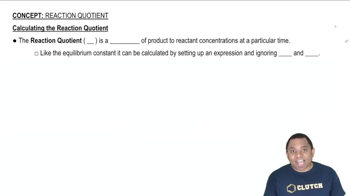Textbook Question
(a) If Qc < Kc, in which direction will a reaction proceed in order to reach equilibrium?
1
views
 Verified step by step guidance
Verified step by step guidance



(a) If Qc < Kc, in which direction will a reaction proceed in order to reach equilibrium?
(b) What condition must be satisfied so that Qc = Kc?
(b) At the start of a certain reaction, only reactants are present; no products have been formed. What is the value of Qc at this point in the reaction?
At 100°C, the equilibrium constant for the reaction COCl2(𝑔) ⇌ CO(𝑔) + Cl2(𝑔) has the value 𝐾𝑐 = 2.19×10−10. Are the following mixtures of COCl2, CO, and Cl2 at 100°C at equilibrium? If not, indicate the direction that the reaction must proceed to achieve equilibrium.
(a) [COCl2] = 2.00×10−3 M, [CO] = 3.3×10−6 M, [Cl2] = 6.62×10−6 M
(b) [COCl2] = 4.50×10−2 M, [CO] = 1.1×10−7 M, [Cl2] = 2.25×10−6 M
(c) [COCl2] = 0.0100 M, [CO] = [Cl2] = 1.48×10−6 M